Careers

Join Our Team
If you're ready to join our collaborative, purpose-driven teams, we’d love to hear from you!
View Our Positions(Link opens in new window)OUR BENEFITS
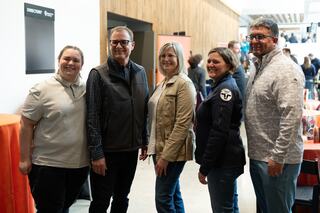
Our benefits package is designed to support employee health and well-being, professional growth, and life outside of work—from comprehensive health coverage and paid parental leave to unique perks like access to our company-owned Sunriver, Oregon retreat.
Comprehensive health insurance coverage
Your health and peace of mind matter. Eligible employees receive comprehensive medical, dental, and vision. The company fully covers vision, life, and disability insurance, along with contributions to a health savings account (HSA).
Retirement benefits
Lewis helps you plan for your future. Participate in our 401(k) plan with 100% employer match up to 5% of eligible earnings. Gain ownership through the Employee Stock Ownership Plan (ESOP), which becomes fully vested after five years.
For the whole you
Benefits include generous PTO accrual based on tenure. Receive a $1,300 Lifestyle Spending Account for health, wellness, and lifestyle related expenses. Access a wide range of wellbeing resources, including app-based tools, confidential EAP counseling, and Regence wellness support.
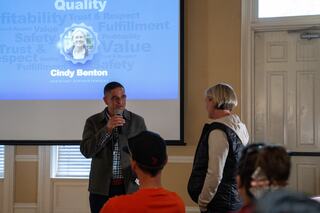
A COMPANY OF OWNERS
Every eligible employee has an ownership stake in the business.
Since 1886, Lewis has been building more than projects; we’ve been building a legacy. Being employee-owned since 2008 ensures that legacy stays in the hands of the people who make it possible. Our Employee Stock Ownership Program supports the employee ownership culture at Lewis, empowering team members to make good business decisions at every level of the organization. That stability allows us to focus on thoughtful growth, employee development and maintaining the values that make Lewis special.
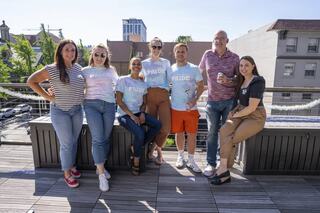
EVERYONE COMMITMENT
Lewis is a place for everyone.
We welcome people of all races, ethnicities, genders and backgrounds. We know that creating a diverse and equitable workforce is a process—a process that takes passion and buy-in from everyone. Our people are the foundation of our success, and we celebrate the differences that allow each of us to bring our authentic selves to work. We embrace and support trade partners that are women-owned, minority-owned, LGBTQIA-Owned, veteran-owned and more to maximize opportunities for all.
Our Culture
OUR PEOPLE
20 years, one healthcare campus
Senior superintendent Shane Weller joined Lewis as a carpenter in 1999. In 2002, he took over as superintendent at Fred Hutch Cancer Center. He’s been a fixture there ever since. “It’s not just building a building and walking away,” he says. “In this work, we’re helping people live.”
Click to Read Shane's Story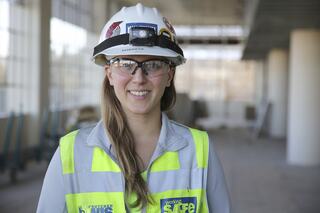
OUR PEOPLE
Finding Her Voice.
Gaining a foothold in the construction industry wasn’t always easy for Sharaya Hays. From project engineer to foreman to estimator, Sharaya carved her own path at Lewis.
Click to Read Sharaya's StoryAt Lewis, we invest in the tools, equipment, and training employees all need to grow and thrive.
See Open Positions(Link opens in new window)News
Stories about our people.
All Team News
Foreman Feature: Lorie Tibbetts
If you’ve ever admired a large-scale Lewis commercial project in Seattle, there’s a good chance general foreman Lorie Tibbetts helped build it.
Over her career, Lorie and her crews have placed more than 560,000 cubic yards of concrete. That’s 2.2 billion pounds of material.
Her journey with Lewis began back in 1990. She was 22 when a friend suggested she ask a superintendent for a spot on the Second & Seneca tower project. Before long, she found herself helping with a concrete pour, rake in hand.
That opportunity launched a career defined by both technical expertise and the ability to build strong, close-knit crews. Ranging from six to eight people, Lorie’s teams move together from job to job and handle everything from building structures, to flagging, to final cleaning.

ENR Names Dustin Zyph a Top Young Professional in the West
We’re thrilled to share that Engineering News-Record has named Lewis superintendent Dustin Zyph a top young professional in the West.
A team of independent judges selected Dustin and 29 other honorees hailing from Calif., Wash., Ore., Nevada, Alaska and Hawaii.
Now in his 20th year with Lewis, Dustin’s journey began as a first-period carpenter apprentice at just 18. Since becoming a superintendent, he’s helped deliver some of our most complex progressive design-build projects to date. He also brings deep expertise in medical, life sciences, and education projects.
Dustin’s career reflects dedication to his craft and the wider industry. He helps support the next generation of builders through his involvement in pre-apprenticeship programs like ANEW, Sawhorse Revolution, and YouthCare Seattle’s YouthBuild, creating pathways into construction for underrepresented groups and growing construction’s talent pipeline.
He’s also a community leader, whether its co-captaining Lewis’ Obliteride team for Fred Hutch or coaching youth wrestling in his hometown of Stanwood.
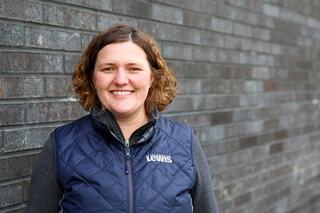
Project Manager Profile: Ashlee Blessing
Senior project manager Ashlee Blessing hadn’t planned on building a career in construction. As an undergraduate studying interior architecture at the University of Oregon, she worked part-time for a small design-build company in Eugene that specialized in student housing and light commercial projects.
During her three years there, the occasional site visit sparked something unexpected. “I just realized I felt more at home in the field learning how buildings come together from the ground up,” she says.
That realization led to a pivot, and eventually, a two-decade career managing complex higher-education and K-12 construction projects in Oregon’s South Willamette Valley.
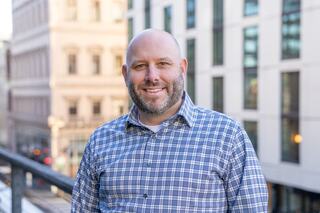
Welcoming Senior Superintendent Kory Ray to Lewis
A chance interaction set Lewis Senior Superintendent Kory Ray on the path to a 25-year career in commercial construction.
At 18, Kory joined his father—a school district facilities director—on a tour of a construction site in their hometown of Lebanon, Oregon.
While watching a framing crew at work, Kory made some observations. A site superintendent overheard Kory and asked, “Do you want a job?”
At the time, Kory was juggling classes at nearby Western Oregon University and part-time work at an auto supply store. But construction sounded like a better fit. He’d learned about it during summers spent re-siding and painting homes with his father.
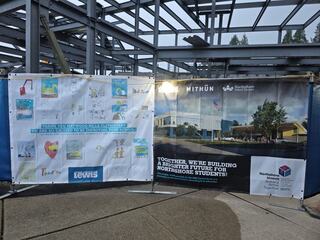
Building Connections: Maywood Hills Elementary Students Put Imprint on Project
This fall, second and third graders from Maywood Hills Elementary School in Bothell, Washington, reached out to our team with artwork and heartfelt thank you letters for the work crews are doing on campus.
The students’ letters include thoughtful questions to feed their natural curiosity about how things are built.
To show our appreciation and share in students’ enthusiasm, we incorporated the artwork into a custom fence panel on-site—a small but meaningful way for us to thank them and celebrate the improvements coming to Maywood Hills.
The progressive design-build project for the Northshore School District will introduce a new two-story addition with seven teaching spaces and a cafeteria. The project also includes a fully inclusive playground, a covered play structure, and an interior refresh integrating existing spaces with new ones.
In addition to Maywood Hills, Lewis is also completing campus improvements at Northshore’s nearby Kenmore Elementary School.
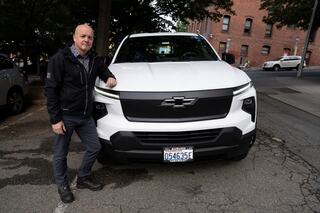
Going All-Electric: A Superintendent’s Early Impressions
After seven years, 133,000 miles, and countless work trips across the Pacific Northwest, Lewis general superintendent Doug Maxfield agreed it was time to retire his old work pickup earlier this year.
When it came to choosing a replacement, Doug jumped at the opportunity to drive one of Lewis’ first all-electric rigs. His father owns a Tesla, so he mostly knew what to expect. In July, after a 15 month-long wait, Doug’s 2024 Chevrolet Silverado EV arrived.
As the lead superintendent for Lewis’ Data Center and Advanced Technology group, his job often takes him from the greater Seattle area to Hillsboro, Oregon, where Lewis has active data center projects.
The 231-mile trip covers about half of the truck’s estimated range. To get home, he needs to factor in about 13 hours of charging time (one hour for every 17 miles) on the jobsite to reach the recommended 80-percent charge level. (Getting all the way to 100-percent takes significantly longer.) Even with all the long-distance driving, Doug says the truck’s batteries rarely fall below 20-percent charged.
If needed, Doug has the option of using one of many fast chargers in Hillsboro, which take a half-hour to reach the 80% charge level.
“The issue of ‘range anxiety’ for me just hasn’t been an issue,” he said.
When home, Doug charges the Silverado EV overnight in his driveway using a Lewis-provided charger, which draws on the solar energy that powers his entire house.
“The driving experience is pretty unique,” he says. “The truck is sporty. It gets up and goes. It’s not a slouch.”
Not with an estimated 510 horsepower and 615 lb-ft of torque, which can be delivered near-instantaneously. One notable difference from his old truck, he says, is the EV’s added heft, with the battery packs contributing to the Silverado weighing more than 8,000 pounds.
To help guide other Lewis employees interested in going all-electric for work, Doug logs his EV’s monthly usage of kilowatt-hours of electricity per 100 miles travelled, or MPGe, and the associated costs. He estimates he’ll spend just $1500 to power his truck in its first year—a fraction of what he might’ve spent on gas for his old pickup, which averaged 20 miles per gallon.
Doug’s Silverado EV is one of Lewis’ three new all-electric vehicles—two trucks and a van—being evaluated as part of a potential shift away from a fleet of gas-powered vehicles and equipment. In Washington state, Lewis’ Bothell-area equipment yard is currently undergoing infrastructure improvements to support those potential changes.
After three months of driving, Doug has already reached a determination about his all-electric rig.
“I wouldn’t hesitate recommending it to others.”
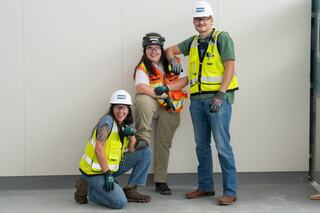
Student, Intern, Employee: How Three Friends Went from Classmates to Coworkers at Lewis
Jaron McGillivray (JM), Kayla Kumle (KK), and Paige Dieckmann (PD) share a unique journey. They all went through the construction engineering management (CEM) program at Oregon State University (OSU), interned at Lewis and now work as project engineers out of the Eugene, Oregon office. Their strong friendship, forged during their time at OSU, played a crucial role in their ability to navigate challenges and ultimately influenced their decision to build their careers at Lewis together.
Jaron, Kayla and Paige graduated from OSU in June and are all officially Lewis employees as of August. We recently sat down with all three to ask about their career aspirations, their time at OSU, and how they are finding life at Lewis.
Why construction?
KK: I originally dreamed of being a Broadway star, then worked for the Forest Service for a while and considered pursuing a career there. Eventually, I heard about OSU’s CEM program from a former boss. After seeing the impressive job placement statistics for graduates, I was convinced.
PD: My dad was a sheet metal worker, so I always had an appreciation for the trades. I started in chemical engineering, but I soon realized how much time I’d spend behind a desk. That’s when I decided to switch to construction.
JM: I wanted to study mechanical engineering. However, after taking a tour of OSU’s engineering department, construction management stood out as a more interesting career path and allowed for a nice balance of physical and mental work.
When did the three of you first meet?
PD: We first met in the Structures 1 course in the CEM program. We started sitting together and connecting over homework.
JM: Our bond began in the classroom. Paige caught me watching an episode of “The Simpsons” during class and gave me a hard time about it. We started joking with each other, and that sparked our initial connection.
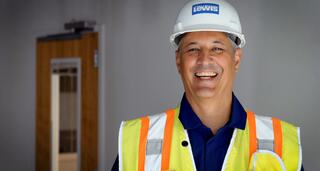
Superintendent Profile: Shane Weller
In 1989, Lewis senior superintendent Shane Weller’s grandfather Bill brought him to the Boeing Red Barn at Seattle’s Museum of Flight.
The structure, the country’s oldest surviving aircraft factory, held special meaning for the Weller family. It was there that Bill closed out his carpentry career in 1983, working on the barn’s restoration before retiring. And the project’s superintendent was none other than Shane’s father and Bill’s son.
As they walked the two-story structure and its exhibits that day, Bill would stop to show his 18-year-old grandson a detail here and a challenge overcome there.
“Well, what’d you think?” he asked Shane when it was time to go. “Want to be a carpenter?”
“Well, sure!” Shane remembers answering.
That same afternoon, they drove to the Carpenters’ Union Building together, where Shane signed up to become a member. In doing so, he set himself on a path to becoming a third-generation builder. (His uncle was also a carpenter.)
“I didn’t know what I was going to do with my life,” Shane recalls. “It felt like a good thing and it’s turned out to be a great career.”
Shane joined Lewis as a carpenter in 1999, first working on the Seaboard Building renovation project in downtown Seattle before being promoted to foreman. In 2002, he took over as superintendent at Fred Hutchinson Cancer Center. He’s been a fixture there ever since.
While most superintendents tend to move on after projects are complete, Shane has chosen to stay on and support Fred Hutch.
The variety of the work and the mission have kept him coming back.
“I really feel strongly about what I do here,” he said on a recent Thursday morning from a rooftop deck that overlooks Lake Union. “Helping cure cancer—it’s pretty awesome. It’s not just building a building and walking away. In this work, we’re helping people live.”
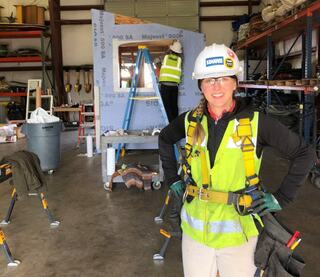
WIC Week Profile: Estimator Sharaya Hays
As a high schooler on summer break in her hometown of Anchorage, Alaska, it wasn’t unusual to find Sharaya Hays laying on the grass in her backyard, sketching houses and floor plans on graph paper. She was sure she’d be an architect.
Her passion for design could be traced to her dad, Cam, who owned a solo residential contracting business. In the summertime, she’d tag along to see the homes he was renovating. Eventually she started helping out, installing Trex decking, building masonry retaining walls and painting interior walls.
It was only after majoring in architecture at Washington State University that she had a change of heart.
“I vowed before graduating I’d never be an architect,” Sharaya says, even though she did still graduate with the degree.
Instead, she went to work as a field engineer for a large national general contractor in Portland. The company asked her to commit to one of two career tracts within six months of joining: project manager or superintendent. She opted for the latter.
In addition to her field-engineering duties, she attended carpenters union classes and logged hours as a carpenter’s apprentice. Five years later, after journeying out with the same general contractor, she felt she was being pressured back into an office role. What made her such a valuable contributor—her comfort level with technology—became the reason she was being pulled out of the field.
“They weren’t listening to what my goals were,” Sharaya recalls. “They were doing what made more financial success for them, which in this case, was me switching to the project manager path.”
She decided to part ways with the company and took an 18-month break after her second child was born. She joined Lewis in the summer of 2018 as a project engineer with the company’ preconstruction department, deciding it would be beneficial to learn how projects are shaped on the front end.
One day, while interviewing a job candidate with Lewis director of operations Robert Jepsen, Sharaya mentioned that she’d always seen Lewis as her ‘unicorn’ company and that she wanted to be back in a field role someday. That caught Robert’s attention.
“After that meeting, Robert pulled me aside and said, ‘You’re the [real] unicorn!’” Sharaya remembers.
Robert helped Sharaya transition into her second role at Lewis: as a foreman working in Lewis’ corporate market sector (formerly the special projects team).

Building a High-Performing Life Science Team
As career builders, few things faze Lease Crutcher Lewis’ life science team. Architectural concrete, cGMP spaces, below-grade research suites with highly sensitive vibration requirements, interstitial floors packed with enough MEP infrastructure to service a small village—we’ve built that.
At the same time, we acknowledge that life science projects are tough. From coordinating lab benches and equipment with MEP and lab gasses, to specialty water and waste systems, to building clean rooms inside operating facilities, each project comes with its own unique set of challenges.
That makes you wonder: what ingredients make such complex projects successful? More often than not, it starts with having highly fulfilled and aligned teams.